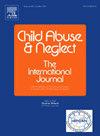逆境综合测量(CAM):早期逆境及其严重程度的测量方法
IF 3.4
2区 心理学
Q1 FAMILY STUDIES
引用次数: 0
摘要
背景早期逆境量表的内容覆盖面往往不足,而且通常只评估逆境的存在,而不评估逆境的严重程度。方法我们进行了一项横断面研究(N = 1498;43.9% 为女性;24.42 岁,SD = 3.72,年龄范围:18-30 岁)和一项纵向研究(N = 1084;39.6% 为女性;32 岁,SD = 10.49,年龄范围:18-75 岁)。结果探索性因素分析表明,存在/不存在面和严重性面均为单因素模型,在随后的确认性因素分析中均显示出良好的模型拟合度。因子模型在不同性别和国家(美国/英国)之间至少表现出标度测量不变量。CAM与心理困扰、抑郁、焦虑、药物使用、创伤后应激症状、强迫症状、自杀企图、反刍、社会比较、自尊和生活质量之间的相关性证明了建构有效性--同时性和前瞻性。本文章由计算机程序翻译,如有差异,请以英文原文为准。
The Comprehensive Adversity Measure (CAM): A measure of early adversity and its severity
Background
Early adversity scales often display insufficient content coverage and typically assess the presence of adversity, but not its severity.
Objective
To address some of these limitations, we developed the 13-item Youth and Childhood Adversity Scale. We subsequently revised and expanded the scale regarding content coverage and item wording, resulting in a 22-item version, which we here describe.
Methods
We conducted one cross-sectional (N = 1498; 43.9 % females; 24.42 years, SD = 3.72, range: 18–30 years) and one longitudinal study (N = 1084; 39.6 % females; 32 years, SD = 10.49, range: 18–75 years). To reflect the nature of the revised measure more accurately, it was named the Comprehensive Adversity Measure (CAM).
Results
Exploratory factor analysis suggested a one-factor model for both the presence/absence and the severity facet, which both displayed good model fit in subsequent confirmatory factor analyses. Factor models demonstrated at least scalar measurement invariance across gender and country (US/UK). Correlations with psychological distress, depression, anxiety, substance use, posttraumatic stress symptoms, obsessive-compulsive symptoms, suicide attempts, rumination, social comparison, self-esteem, and quality of life provided evidence in support of construct validity – concurrently and prospectively.
Conclusions
The CAM offers a psychometrically-sound, content-wise comprehensive, and free to use assessment of early adversity.
求助全文
通过发布文献求助,成功后即可免费获取论文全文。
去求助
来源期刊

Child Abuse & Neglect
Multiple-
CiteScore
7.40
自引率
10.40%
发文量
397
期刊介绍:
Official Publication of the International Society for Prevention of Child Abuse and Neglect. Child Abuse & Neglect The International Journal, provides an international, multidisciplinary forum on all aspects of child abuse and neglect, with special emphasis on prevention and treatment; the scope extends further to all those aspects of life which either favor or hinder child development. While contributions will primarily be from the fields of psychology, psychiatry, social work, medicine, nursing, law enforcement, legislature, education, and anthropology, the Journal encourages the concerned lay individual and child-oriented advocate organizations to contribute.
 求助内容:
求助内容: 应助结果提醒方式:
应助结果提醒方式:


